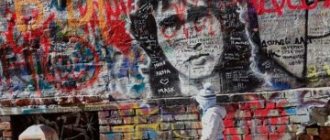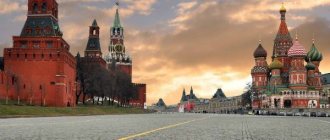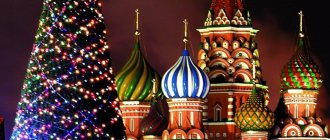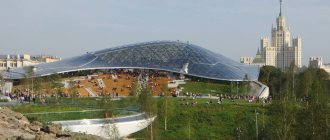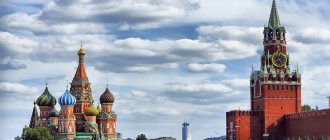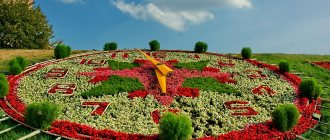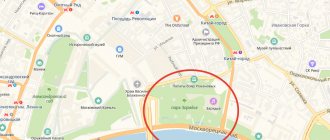HomeTourists Tips for travelers
An interesting to-do-list (a list of things that must be done) for tourists visiting Moscow was published by a native of Connecticut, Bill Martinski, who lives in Moscow. It is noteworthy that the list did not include either the Arbat or many other Moscow attractions “especially for foreigners.”
At the beginning of his post, published on the portal globalhobos.com, the author stipulates that the list of these 11 things to do or see in Moscow is largely a reflection of his personal tastes. However, other foreign tourists in Moscow, in our opinion, should listen to the advice of this man, who lived in Moscow for several years - after all, his knowledge of the Russian capital is by no means superficial.
Moreover, Bill Martinski’s advice will be useful both to Russian tourists arriving in Moscow and, paradoxically, to Muscovites themselves. After all, it is always important to look at your hometown “from the outside,” with an unclouded look.
11. TRY HOMEMADE PANCAKES
“The best way to get to know a culture and a country is through its national cuisine,” the author writes, adding that “Russia is known in the world mainly not for its cuisine.” The first thing you should definitely try in Moscow from Russian cuisine is pancakes. Their author advises trying to eat it for breakfast (and sometimes for lunch and dinner too).
“Russian pancakes are thicker than the crepes we are used to, and, in my opinion, tastier,” he writes. What’s especially interesting, according to Mr. Martinski, is that they can be eaten with both sweet and savory fillings: for breakfast you can have pancakes with berries or jam or condensed milk, and for lunch you can have the same pancakes, but with cheese and mushrooms or smoked salmon. Thanks to such “variability” of the filling of Russian pancakes, the author believes, they present an amazing palette of flavors for a gourmet. They're "sophisticated," he adds—if you don't get them from a chain restaurant.
He advises tourists to come to Moscow for pancakes for a week in early spring, during Maslenitsa, before Lent among the Orthodox. At this time, a wide variety of pancakes are sold everywhere in the city - in parks, main hubs of the city, and even on Red Square.
Where to take a foreigner in Moscow in summer and spring
Moscow Kremlin and Red Square
The ensemble, which included the main square of the country and the Moscow Kremlin, over the centuries has turned into a real symbol of Russia. It took 500 years to acquire its modern appearance. Its appearance combines features of traditional Russian and European architecture. For centuries, the Kremlin served as the residence of monarchs, and in the 21st century it became the seat of government of the President of the Russian Federation.
The territory of the ensemble is fenced with monumental walls that form a triangle with unequal sides. Its total area reaches 27 hectares. The southern Kremlin wall faces the river, the northwestern one faces the Alexander Garden. From the east, the Kremlin adjoins Red Square.
Note. If a guest has arrived in Moscow for a day, then during this time he should look at the most important thing - the Kremlin. To do this, you need to get to Red Square by metro or public transport. If time permits, you should definitely visit the Armory Chamber and the Diamond Fund. And the most striking photographs are taken against the backdrop of the Tsar Bell and the Tsar Cannon.
Moscow City
The business center, where the offices of the largest domestic and foreign companies are located, is a new attraction. This ultra-modern complex consists of several skyscrapers built from glass and concrete. The lowest skyscraper has 27 floors, and the highest has 96 floors. The center is located in a bend of the Moscow River. You need to focus on Krasnopresnenskaya embankment, which is located 4 km from the Kremlin.
The buildings of Moscow City, and there are 16 of them in total, were built in the style of neo-constructivism and high-tech. Everyone has their own name. The two largest ones were given names in honor of Moscow and St. Petersburg. Guests of the capital will definitely be interested in exhibitions, excursions around Moscow and visits to shops.
Foreigners should definitely go up to the PANORAMA360 observation deck, located on the 89th floor. Currently, it is the highest in the country, as recorded by the Russian Book of Records. The place is interesting not only for its magnificent views of the city, but also for its ice cream factory and numerous entertainment areas.
At the epicenter of the architectural complex there is the largest fountain in Europe, the jets of which shoot to a height of 36 meters. Also worth paying attention to is the atrium, from where a giant dome of metal and glass rises.
Moscow parks
When deciding what to show a foreigner in Moscow in the summer, you should definitely remember the numerous parks and squares, among which the most popular are:
- Victory Park on Poklonnaya Hill
. This is a memorial complex and park created in honor of the victory in the Great Patriotic War. It began to be built in 1987. At the same time, part of the hill on Poklonnaya Hill was removed. The park was officially opened to visitors only in 1995. In the center of it stands a huge obelisk, which is crowned with a sculpture of the goddess Nike. Its total height reaches 141.8 meters. The Eternal Flame burned on Poklonnaya Hill from 2009 to 2010, when reconstruction was underway at its permanent location in the Alexander Garden. - VDNKh (VVC)
. A huge number of exhibition pavilions demonstrating the achievements of the national economy are located in the north-eastern part of the city. Here you can not only stroll around various exhibitions, but also have a pleasant rest in the company. Cafes, concert venues, fountains and alleys - all this made the All-Russian Exhibition Center a favorite vacation spot for Muscovites and tourists. - MUZEON Art Park
. A real art zone stretches along the Crimean embankment. Outdoor exhibitions are held here. There are gardens with fountains, walking paths, and various art objects around. People come here with their children and also make dates. For a foreigner, a visit to the park will leave cheerful and vivid memories of Moscow. - Gorky Park
. One of the most picturesque corners of the Moscow River embankment. It is no coincidence that it is chosen to host cultural events of various sizes, for example, environmental rallies, festivals for vegetarians, and skateboarding competitions. The most significant holidays celebrated on a citywide scale certainly affect this park, where an ice skating rink opens in winter. - Tsaritsyno Museum-Reserve.
The palace complex in Tsaritsyno invites you to admire real Russian Gothic architecture. The hilly area is lined with a cascade of ponds. At one time, Francis Reid, one of the best gardeners of those times, arrived from England to lay out the local gardens in the true English spirit. Initially, the ensemble was destined for the role of a royal residence. Construction took place in the 18th century. Today people come here to visit museums and thematic exhibitions, concert halls and magnificent greenhouses. At the entrance, stylized as the gate of a medieval castle, there is a musical fountain, which can be reached via two special walkways. - Sparrow Hills
. The best observation deck in the capital is located in Vorobyovy Gory. In fact, these are not mountains at all, but a hilly river bank, the topography of which is cut by numerous landslides and cliffs. And clean springs flow right out of the ground. In prehistoric times there was a sea here, and much later one of the first settlements appeared. The observation deck on Vorobyovy Gory appeared in 1953. From its top you can see all the most significant sights of Moscow: New Arbat, Luzhniki, Ostankino TV Tower and much more.
BARGAIN AT IZMAILOVSKY MARKET
“When I’m going to buy something in Moscow other than food, I almost always go to the Izmailovsky market,” the author writes. He adds that this is not just a market where you can buy something, it is, first of all, an indescribable emotional experience.
This is the largest open market in Moscow, consisting of hundreds of “tents” and shops run by local residents. And here you can get everything, and even more, than you thought you could buy in Russia, notes Mr. Martinski.
“Old Soviet souvenirs and memorabilia? Yes! Home stuff? Yes! Paintings and other art objects? Yes. Honey from the apiary and craft alcohol? Skullcaps, Russian hats with earflaps, hand-carved chess sets? And they are. So if you need to bring a gift to friends or relatives from Russia, you absolutely need to come here,” the author sums up. According to him, everything here is more varied than in stores, and much cheaper - if you know how to bargain.
“And even if you don’t want to buy anything here, it’s great to just wander around and practice your Russian with the local merchants,” he adds.
“Oh yes, one more thing! The Izmailovsky market is located next to the “second Moscow Kremlin. Many people do not know that there are two Kremlins in Moscow. One, huge and made of stone, is Putin’s residence – located where Red Square is. And the second, much more modest in size, wooden and very colorful, located near the Partizanskaya metro station - this is exactly the one next to the market,” explains Bill Martinski.
Autumn events in Moscow
The beginning of autumn in Moscow is associated with a grandiose event - City Day . This is a large-scale celebration that is not limited to one day and attracts millions of spectators. Events take place on several stages in different areas. The program includes dance and musical performances, performances, performances by magicians and acrobats, master classes, sports competitions and competitions. And in the evening, stunning fireworks display awaits residents and guests of the capital.
Another bright autumn event is the Circle of Light festival . This thematic light show has been held in Moscow since 2011. Teams of artists paint the facades using lasers and graphics, turning them into a fairy-tale spectacle. Every year the program and location of the festival changes.
Lovers of tasty treats should visit the Golden Autumn festival in Moscow. At this gastronomic festival, farm products from different parts of the country are sold. Hundreds of small and large producers present their products, conduct culinary master classes and tastings.
Festivals, holidays, shows in Moscow
Festival "Golden Autumn" in Moscow Photo: © Valeria Belousova
SEE THE MONUMENT TO GAGARIN
This monument is not one of the famous Moscow monuments that you can find in any tourist brochure. “Before I got here, I had no idea that it existed,” the author writes. – It all happened when I left the Leninsky Prospekt metro station, heading towards Vorobyovy Gory. I was amazed by this huge silver statue, a little reminiscent of “Superman”, as if flying into the heavens. The monument was created in the Soviet era, its faceted shapes make it very majestic.”
Bill Martinski believes that this monument to the first cosmonaut is a real discovery for tourists. With rare exceptions, the Gagarin monument in Moscow is unknown to tourists, and foreigners in general, and besides, it is remote from the historical one. This is a rare and unique monument of the Soviet past, which is a must see in Moscow, the author believes.
LOOK AT LENIN
“Would you like to look at the “preserved” body of a communist revolutionary from the early 20th century? If yes, then this can be done, and even for free, by coming to the Lenin Mausoleum on Red Square from 10 to 1 pm on certain days and standing in line. Wherever you look, you will immediately see that “LENIN” is written on the building in large letters,” writes Mr. Martinski.
Visitors are warned to be quiet and not to take photographs. Then, after passing a couple of corridors, you will find Vladimir Ilyich Ulyanov himself aka Lenin - the leader who led the Bolshevik October Revolution, lying in a glass sarcophagus and dimly illuminated by red light.
“In general, the impressions were eerie, but one thing struck me most of all. Lenin was very short. Very low. Probably no more than 140-142 cm – and that was a discovery. Previously, he seemed to me to be a majestic, tall man. Actually this is not true. But it’s worth seeing for yourself,” the author recommends.
Lenin Mausoleum
This place is called differently: a museum, a monument. In fact, this is the tomb of Vladimir Ilyich Lenin. The Mausoleum is located near the Kremlin walls. The modern building was erected in 1930, replacing the wooden structure. Black marble, porphyry, labradorite, smalt and granite were used as facing materials.
To get inside, you need to enter the building through the main entrance and go down to the funeral hall along the left staircase. Here you can walk around the sarcophagus on three sides, for which a special podium is designed. Exit the hall along the right staircase. While visiting the Lenin Mausoleum, you must not use cameras or keep your hands in your pockets. After such an excursion, all people, even foreigners, feel some kind of anxiety, which is not surprising, because they have the opportunity to look closely at the leader of the Soviet Union.
TAKE A WALK ON THE PATRIARSHY PONDS
“One of my favorite books is “The Master and Margarita” by Bulgakov, and if you know this work, you will understand why this place in Moscow is on my list,” writes the author. Patriarch's Ponds, he says, were included in the list not only because the history of the book begins with them, but also because the house of its author, Mikhail Bulgakov, is located here, currently converted into a museum. It offers a beautiful view of the pond itself. Nearby there are cute establishments with names related to the novel - for example, the Begemot cafe (named after the demonic talking cat from Bulgakov's book).
Regardless of the connection with Bulgakov's novel, writes Bill Martinsky, Patriarch's Ponds are a wonderful place in the city. The greenery of trees and comfortable paths laid along the water surface, cozy benches in the shade of the crowns where you can sit down to relax - a great place to enjoy a good day in Moscow.
And there are also a lot of interesting and strange things here - for example, interesting sculptures depicting animals that act like people are scattered around the perimeter of the square - they are worth looking at in themselves.
“The only thing that confuses me is the mistake in the name of the place itself. There is only one pond here, so don’t believe the plural in the name. But he himself is very beautiful and worth coming here,” the author sums up.
Second day. Parks and museums
On your second day in Moscow, plan to explore the capital's parks or museums. Much will depend on the weather: on rainy and frosty days it is better to give preference to exhibitions, and on sunny and warm days it is better to spend more time outdoors.
Museums of Moscow
Of the capital's museums, the compulsory program usually includes the two most famous ones - the Tretyakov Gallery and the Pushkin Museum of Fine Arts . Both institutions are famous for their rich collections of paintings, graphics and sculpture. Art connoisseurs spend a good half of the day in the exhibition halls, but some tourists only need to see the most valuable masterpieces.
Pushkin Museum Photo: © Yaroslav Glukhov
For those who want to visit both museums, it is better to start with Pushkinsky on Volkhonka. Not far from it rises the main cathedral of the Russian Orthodox Church - the Cathedral of Christ the Savior . While inside, don't forget to go up to the observation deck of the cathedral and take great photos of the center of Moscow.
Tretyakov Gallery Photo: © Yaroslav Glukhov
There are two ways to get to the Yakimanka district, where the main building of the Tretyakov Gallery is located:
- First: from the temple go out onto the Patriarchal Bridge and follow it to Yakimanskaya Embankment . Here turn left and walk along the canal to Lavrushinsky Lane; the museum buildings start right from the intersection.
- Second option: from the Cathedral of Christ the Savior along Prechistenskaya embankment , move towards the Bolshoy Kamenny Bridge , and cross it to Bolotny Island . Repinsky Square will appear near the Vodootvodny Canal . It’s worth coming here to see the monument to M. M. Shemyakin “Children are victims of the vices of adults . The Luzhkov (Tretyakovsky) Bridge leads from the park to Lavrushinsky Lane .
All museums in Moscow
Monument “Children - Victims of Adults’ Vices” Photo: © grau59
Parks in the center of Moscow
Moscow's central parks are united into a single green zone. The first point of the walk will be the Muzeon Art Park along the Crimean embankment . The New Tretyakov , awaits visitors at Muzeon .
Throughout the park there are sculptures and monuments to famous personalities, and there are attractions.
Muzeon Art Park Photo: © Juliette17
Immediately behind the Museum, travelers are greeted by the main entrance to Gorky Park . The most favorite park of Muscovites is equipped with everything they need for relaxation. On numerous paths and alleys, flower beds and fountains await visitors, there is an observation deck, and boat and bicycle rentals are available. While strolling through the park, stop by the Garage Museum of Contemporary Art or book a tour of local attractions.
Gorky Park Photo: © Katerina Solosyatova
From Gorky Park, go to the Neskuchny Garden with the Alexandria Palace and the Mineralogical Museum of the Russian Academy of Sciences .
Behind the Neskuchny Garden stretches the famous Sparrow Hills . The Main Building of Moscow State University deserves special attention here . another observation deck “Sparrow Hills” in the park itself, not far from the new cable car . It will allow you to capture beautiful panoramas of the Luzhniki Stadium and the Moscow City .
Vorobyovy Gory Photo: © vladkonst
If this is not your first trip to Moscow, then you have probably already seen some of the sights. Exploring other areas of the city will help diversify your vacation. The VDNKh and Izmailovsky Kremlin complexes deserve special love from guests of the capital ; you can spend the whole day there, walking through museums and riding attractions.
For more information about where to go in 2 days in Moscow, read the advice: What to see in Moscow in 2 days on your own
Moscow City Photo: © bazell
VISIT RED SQUARE AND THE KREMLIN
“I am aware that Red Square is considered the number 1 place in Russia and is valued above other tourist attractions, but I myself will say that it is a must-see,” says Bill Martinski.
“I still remember how I ended up here for the first time - I walked through the [Iveron] gates and saw St. Basil's Cathedral and the Kremlin in front of me in all its glory. It was unreal - as if I was walking on a film set. Not a single picture could convey the real atmosphere of this place. The scale itself, the colors, the surrounding history – all these are incomparable sensations,” he adds.
The author advises tourists that if they have a full day to explore, go inside the Kremlin and see it in its entirety. “More than three-quarters of the Kremlin territory is now open to tourists, and you will have the opportunity to explore the Armory, the throne rooms of the Tsars, and thousands of artifacts of Russian history,” he writes.
Also, Mr. Martinski adds, it is worth familiarizing yourself with the calendar of events held here: Red Square hosts many demonstrations, parades, exhibitions, holidays - and all of them are “organized with the greatest possible grandeur,” so you should not miss out on the valuable experience of participating in one of such celebrations or festivals.
Pavilions and park of VDNKh
VDNKh is a real pride not only for Muscovites, but also for residents of all of Russia. The scale of the exhibition simply cannot but surprise. On its territory you will definitely be able to find a lot of interesting things for a foreign guest, and the local park will help you have fun. A visit to VDNKh should be included in the program; it will take a whole day, which is not enough to completely get around everything.
Back to Contents
VISIT PUSHKIN SQUARE IN WINTER
“Winter in Moscow is best described by two adjectives – “long” and “cold”. Sometimes it lasts from October to May, and the temperature drops below minus 30 Celsius at its peak. But, to the credit of the city, Moscow is well prepared for this kind of severe climate testing, and in my opinion, there is no better place in Moscow where this preparation is as obvious as on Pushkinskaya Square and Tverskaya Street,” says Bill Martinski.
He notes that from the beginning of December to the beginning of February, this entire area is filled with numerous decorations and illuminations. Bare tree branches are hung with live lights, and festive, elaborate decorations are on every street lamp.
Both the illuminations and the scenery change every year, just like Moscow itself, “a dynamic and changing city,” but each time “it’s a magical spectacle, especially in combination with the snow,” the author adds. “And if you find yourself in Moscow in winter, try to walk here in the dark - believe me, despite the cold, it’s worth it,” concludes Bill Martinski.
Attractions
Autumn in Moscow is a great time to travel. The flow of tourists is drying up and huge queues to museums are no longer as common as in summer. The theater season starts, and the city's posters are filled with interesting concerts and festivals. Even if the weather is unlucky, you will always find something to do.
Independent walk around Moscow
To see the main cultural monuments of Moscow, come to Red Square . Ancient temples, museums with royal treasures and historical buildings await everyone behind the fortress walls of the Moscow Kremlin .
St. Basil's Cathedral on Red Square Photo: © Maksim Starostin
You can walk along the central streets and squares of Moscow for hours and everywhere you will find interesting places telling about the traditions of Russia, famous people and events. The list of the most popular destinations includes Tverskaya Street , Old Arbat , New Arbat , Volkhonka, Strastnoy Boulevard, Bolshaya Sadovaya Street, Kremlin and Krymskaya embankments, Lubyanskaya Square , etc.
Read more about the sights of the capital in our tips: What to see in Moscow in one day in 2 days in 3 days
Alexander Garden Photo: © Natalya Starostina
Museums
In the fall, exhibitions in the capital's museums and galleries are updated and new exhibitions appear. Among hundreds of cultural institutions, everyone will find something of their own.
Tretyakov Gallery
Perhaps the most famous museum in Moscow, the Tretyakov Gallery, has a valuable collection of paintings, graphics and sculpture. The main building of the Tretyakov Gallery on Lavrushinsky Lane displays icons and paintings by Russian artists of the second half of the 19th century. Here you will see such masterpieces as “Girl with Peaches” by V. Serov, “Morning in a Pine Forest” by I. Shishkin, “Boyaryna Morozova” by V. Surikov, “We Didn’t Expect” by I. Repin, works by I. Kramskoy, V. Vasnetsov , I. Levitan, N. Roerich, etc.
A collection of Russian art of the 20th century is presented at the New Tretyakov Gallery on Krymsky Val (in Muzeon Park ).
More details: Tretyakov Gallery
New Tretyakov Gallery Photo: © chvm2006
Pushkin Museum of Fine Arts
Another large museum in Moscow is not inferior to the Tretyakov Gallery in terms of the number of visitors, but its holdings are hundreds of times larger than the famous gallery. The Pushkin Museum contains exhibits from different eras and countries - from Ancient Egypt and antiquity to modern times. Archaeological finds, sculpture, and paintings are exhibited in the halls. The museum is particularly proud of its collection of Byzantine icons, works by Poussin, Botticelli, David, Picasso, Matisse, Van Gogh, and Paul Gauguin.
Details: Museum of Fine Arts named after A. S. Pushkin
Pushkin Museum of Fine Arts Photo: © miss_Elena
State Historical Museum (GIM)
The Historical Museum on Red Square always surprises. Exhibitions and displays here are constantly updated. Even if you have already been here before, a repeat visit will not be boring, because the number of exhibits in the collections of the Historical Museum is in the millions, and it is simply impossible to go around all the halls at one time.
In the State Historical Museum you will learn about the first settlers, the foundation and development of the state from ancient times to the present day. The showcases display important archival documents, chronicles, personal belongings of rulers and generals, religious and cultural values, books, a collection of ancient Russian paintings, numismatics, weapons, furniture, ceramics and much more.
More details: State Historical Museum
State Historical Museum Photo: © vladkonst
Central Museum of the Great Patriotic War
The Victory Museum on Poklonnaya Hill tells about the battles and heroes of the Great Patriotic War. Military equipment stands in the open air near the walls of the institution, and inside there are stunning dioramas reconstructing terrible battles, and display cases with photographs, weapons, and military awards.
More details: Victory Museum in Moscow
Victory Museum on Poklonnaya Hill Photo: © Margarita Kushnirenko
While walking along Tverskaya Street, take a look at the Museum of Contemporary History of Russia . The exhibition will introduce you to the personal belongings of revolutionaries and political figures. The events of modern history are demonstrated using multimedia technologies.
The Museum of the History of the Gulag in 1st Samotechny Lane will tell about the controversial events in Russia of the 30-50s of the XX century. You will be able to familiarize yourself with letters and works of art by prisoners, archival documents, and memoirs of eyewitnesses.
With children you can go to the Moscow Planetarium , get in a good mood at the Museum of Emotions or the Museum of Soviet Slot Machines , and ride Soviet cars at the Museum of Automotive Stories .
Museums of Moscow
Moscow Planetarium Photo: © bazell
Theaters and concert halls
Before traveling to Moscow in the fall, check out the event schedule. Going to the theater or concert will be an excellent substitute for walks if the weather suddenly lets you down.
There are hundreds of theaters in the capital for every taste. Some of them require special preparation. For example, to get to the Bolshoi Theater , you need not only to buy tickets in advance, but also to choose the appropriate evening outfit.
Bolshoi Theater Photo: © Julia Alisova
Performances based on classical works are staged at the Lenkom Theater , at the Moscow Art Theater. Chekhov and the Academic Theater of V. Mayakovsky , at the Sovremennik Theater and at the Drama Theater named after A. S. Pushkin . See modern productions at the CDKZh , at the Gogol Center , at the Praktika Theater , at the School of Dramatic Art , at Theatre.doc .
Evenings of organ music are organized in the Cathedral of the Immaculate Conception of the Blessed Virgin Mary and in the Cathedral of Saints Peter and Paul . The Moscow International House of Music (MMDM) and the Conservatory specialize in classical music P. I. Tchaikovsky and the Gnessin Russian Academy of Music .
Moscow theaters
Moscow House of Music Photo: © chvm2006
EXPLORE THE MOSCOW METRO
“Since I grew up between New York and Boston, I was used to the “subway” or “subway” being a pretty dirty and generally terrible place. But when I first arrived in Moscow, I was shocked by the local metro,” says the author of a review of Moscow attractions.
He notes that Moscow metro stations are “immaculate,” decorated with crystal chandeliers, stucco, sculptures and wall paintings, and “incredibly spectacular.” Each station is unique, has its own design and decoration style (mostly perpetuating certain events from Russian history). So far there are 14 lines with 20-30 stops each, the author notes, and the frequency with which the trains run is “simply incredible.”
“One day, several of my friends and I decided to start an interesting photo project, taking pictures of the most interesting city metro stations. And although I knew in advance that it would be interesting, it was perhaps one of the most interesting projects I have ever been involved in. We drove through Moscow metro stations in the evening, after rush hour, when there were no longer a huge number of people there, and this gave us the opportunity to consider something that we had not previously noticed,” Bill Martinsky describes his experience.
“If you decide to take a self-guided “tour” of the Moscow metro, you will be able to see a lot of nuances that characterize how this grandiose underground system was built and designed. I recommend that you visit as many Moscow metro stations as you can, but I will still highlight among others such stations as Komsomolskaya, Mayakovskaya, Ploshchad Revolyutsii, Kievskaya, Belorusskaya, Arbatskaya and Prospekt Mira.
Beautiful places in Moscow in winter
You can arrange an excellent photo walk in the capital. Visit the greenhouses of the Moscow State University Apothecary Garden on Vorobyovy Gory. In the glass greenhouses you will plunge into summer and take great photos with flowers in the background. Every winter, the Tropical Winter festival , where orchids and unusual plants are on display.
Greenhouse of the Botanical Garden of Moscow State University Photo: © Elena Aksenova
Do you want to become a part of cinema? Take time to explore the Mosfilm Studio Museum . Visitors are allowed into the town, created for filming films about old Moscow.
Immerse yourself in a Christmas tale at the Roman Catholic Cathedral of the Immaculate Conception of the Blessed Virgin Mary . Musical evenings and evening illumination of neo-Gothic architecture create an atmosphere of magic.
The capital's estate museums continue to operate in winter. Exciting excursions and festive events await you in Tsaritsyno , Kuskovo and in the Kolomenskoye nature reserve .
Tsaritsyno in winter Photo: © Nastenka Pavlik
LISTEN TO MOSCOW UNDERGROUND MUSIC
Most bars in Moscow have DJs and may play electronic music, but it can be described as mediocre at best, writes Bill Martinski.
“But if “on the surface” of Moscow we see a certain “failure” in musical creativity, you can find amazing examples of it in the most unexpected places “in the shadows.” Thus, the instrumental orchestra of Balkan music from St. Petersburg, whose performance I went to after meeting the musicians who were staying in the same hostel as me, completely changed my idea of Russian music. Not only was the show itself colorful, but the music was incredible. It was like a new world had opened up for me. I literally began to dig around in search of new gems of this kind and discovered many other bands that are quite thriving - outside the Russian musical mainstream, as well as a number of "underground" bars and clubs where they perform. Moscow has a thriving underground music culture,” says Bill Martinski.
The places where different groups perform in clubs and bars change weekly, but the author nevertheless advises visiting several “reliable” places where you can discover the real Russian musical underground: these are “Chinese Pilot Zhao Da”, “Gardens of Babylon”, “Smena Bar” and "Wide to Shirokaya."
Moscow Planetarium
The planetarium includes several halls, the interactive Uranium Museum and the Urania Museum, as well as a 4D cinema. Here you can take part in scientific experiments, examine astronomical equipment up close, and even see fragments of meteorites. However, none of this compares to the planetarium sky. The largest screen dome in Europe allows you to admire the starry sky. The opening picture leaves no one indifferent.
2. WALK THROUGH KOLOMENSKOYE PARK
“Every city has a place that you can call “yours.” This is where you can hide for a while from the storms of life, from everyday stress and try to find peace with yourself. In Moscow, such a place is Kolomenskoye Park, writes Bill Martinski.
Despite the fact that this is just one of the many green areas of Moscow, the author points out two reasons that, in his opinion, distinguish the park from other Moscow forested areas.
“First of all, it’s huge. If you go far enough into it, you really get the feeling that you are in the city. Instead of concrete buildings, there are hills, trees, and ancient wooden buildings around you, descending to the banks of the Moscow River. The landscape views in Kolomenskoye are stunning, regardless of the time of year, but this park is distinguished from other Moscow parks by other unique features,” writes the author.
“It’s interesting that in the middle of the park there is a real apple orchard. Thousands of apple trees stand there in rows, and from mid-summer to late autumn you can try real Moscow apples there. And they are good! My friends and I made apple pie filling with them, and although my culinary knowledge is not very impressive, it turned out to be absolutely wonderful in taste. Another nice thing: in winter, the park serves hot toddy with honey or mulled wine - it’s delicious and will help you cope with the cold,” he further says.
"This whole place looks like it's out of time." This is probably helped by the mass of wooden buildings scattered throughout the park. There is a real wooden church of the 15th century, standing on the river bank, wooden houses and an exquisitely decorated wooden royal tower, now adjacent to cozy small cafes. Here you can enjoy views of the hills and river valley while eating Russian dumplings and washing them down with mead. What could be more beautiful? - Bill Martinsky ends his description of Kolomensky on such a sublime and pacifying note.
Moscow parks in autumn
Coming to Moscow in the fall, you risk experiencing “Indian summer”. It usually falls in the second half of September. These days you can enjoy walks through the parks and gardens of the capital and take colorful photographs against the backdrop of bright foliage.
In the very heart of the city, along the Moskva River , there is a huge green area. It starts from the Yakimanka district, where Muzeon Park is located. Walk it from the monument to Peter I to the Crimean Bridge and you will find the main entrance to Gorky Park . Moscow's Central Park continues with the Neskuchny Garden , which in turn borders the Vorobyovy Gory .
Cable car on Vorobyovy Gory Photo: © Natalya Starostina
There are as many as 4 observation platforms on this route. The first awaits guests in Gorky Park. The observation point is located at a height of 18 meters on the roof of the main entrance. Look for the following three places on the Sparrow Hills: good views open from the location near the RAS building , from the most popular observation deck “Sparrow Hills” , which is not far from the park’s cable car and from the 32nd floor of the main building of Moscow State University (the visit is included in the tour of the Museum of Geography ).
Main building of Moscow State University Photo: © Darius A
A photo session in autumn landscapes will preserve the memory of your trip for a long time. You will find picturesque locations in the Hermitage garden , in Sokolniki and Fili . Izmailovsky Culture and Recreation Park is suitable for children's recreation .
Be sure to visit VDNKh , because it is one of the top places. At the beginning of autumn, you will be able to catch the fountain season and admire the legendary fountains “Friendship of Peoples” , “Stone Flower” and “Golden Spike” .
VDNH Photo: © Sergey Vasilets
Museum-reserves
Moscow in autumn is especially beautiful in the palace parks. You can combine pleasant walks with interesting excursions at estate museums.
Tsaritsyno Museum-Reserve
The Tsaritsyno palace complex is a striking example of “Russian Gothic”; people come here to get acquainted with the excellent architecture, explore the exhibitions of local museums or wander through the landscape park. The highlight of the reserve is the Great Catherine Palace , but other buildings have also been preserved: the Small Palace , the Bread and the Opera House , the Cavalry Corps , greenhouses, pavilions, gates and bridges.
More details: Tsaritsyno Museum-Reserve
Tsaritsyno Museum-Reserve Photo: © Rakel
Museum-Reserve "Kolomenskoye"
Not far from Tsaritsyno there is the Kolomenskoye park complex with historical and artistic exhibitions and ancient buildings. Among the architectural monuments of Kolomenskoye, temples are especially valued. The Wooden Palace of Alexei Mikhailovich is also interesting . The building was lost and only thanks to the work of restorers we can today plunge into the atmosphere of Russian life of a bygone era.
More details: Kolomenskoye Museum-Reserve
Wooden palace in Kolomenskoye Photo: © Andrey Panin
Museum-Estate "Kuskovo"
The luxurious Sheremetev estate with a regular park decorated with antique sculptures is a wonderful example of 18th-century architecture. The main house houses a historical exhibition and regularly organizes concerts, including organ evenings.
More details: Kuskovo Estate Museum
Grotto Pavilion in the Kuskovo estate Photo: © Elena Aksenova
VISITING RUSSIANS
“If you have made close friends in Russia, there is a chance that you will be invited to visit for food and drink. It is unlikely, of course, that such a chance will present itself during a short tourist trip (well, unless you knew someone from Russia before), but if such a chance exists, be sure to take advantage of it. “Going to visit” is perhaps the central part of Russian social life, and, to be honest, this is also the best part of my life in Moscow - it makes it clear how and what the local society lives with,” advises the author of the review and then gives several important touches to the portrait of “Russian parties”.
“Unlike most Europeans, Russians prefer to socialize with family and close friends over food or drinks at home, and with more distant acquaintances in bars and cafes. Usually people invite others to their home where food and drinks are already prepared. Everything about food is very important - cultural norms in Russia do not allow alcohol to be served on its own, separately from food, and each serving of an alcoholic drink is always accompanied by an appetizer (mostly a hot dish). In turn, each guest is expected to contribute to the common table by bringing something like light snacks or a bottle of wine - even if the host has prepared more than all the guests can eat and drink, it is considered rude to come empty-handed,” This is how Bill Martinsky describes Russian table traditions.
“When everyone is gathered, everyone has something to drink in their glasses and something to eat on their plates, someone makes a toast and the celebration begins. Everything happens very informally and relaxed, people are deeply immersed in conversations, and often play various “amateur” original games, usually boiling down to solving something,” he continues.
“As for me, “guests” are the best way to experience Russian hospitality. This helps not only to establish strong friendships, but also reveals the “hidden” features of Russian culture. An evening with Russians is never boring, and this interaction with them is one of the most impressive I have ever seen anywhere,” concludes Bill Martinski.
